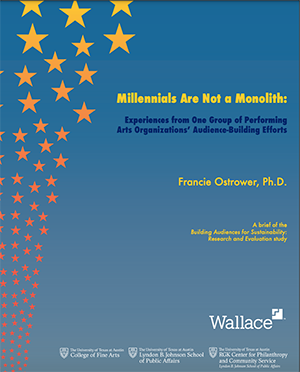Report
Millennials Are Not a Monolith: Experiences from One Group of Performing Arts Organizations’ Audience-Building Efforts

"That is a group that is not engaged with us . . . and it was important, particularly with the rising demographic of the millennials, that we engage that group." These words from a theater director reflect his concern about attracting millennial audiences—one that is prevalent in the nonprofit performing arts. His organization was one of 25 performing arts groups awarded grants to expand and engage audiences as part of The Wallace Foundation's Building Audiences for Sustainability (BAS) initiative. As part of the initiative's approach to audience building, participants were required to define and focus their efforts on a particular target audience. Millennials were the most frequently chosen group. Among the widespread reasons for their choice: Too few young patrons were emerging to replace current and aging audiences, and organizations therefore needed to tap into the large millennial population to create a pipeline of younger audiences. Further, many felt proactive measures were needed to create this pipeline because declining arts education in schools had left millennials with little prior exposure to their art forms. As a marketing director of a dance company said, "If you don't figure out how to engage the millennials, you're going to eventually see your audience diminish, because they are the audience of the future."
But is a demographically-defined age segment, in this case, millennials, necessarily a meaningful target group for the purposes of audience building? Interim findings from our independent evaluation of these organizations' experiences suggest caution about making this supposition. They point to the need for further refinement and careful attention to generalizations and stereotypes that may underlie approaches to millennials as a target group for audience building. It is one thing to focus on attracting millennials because of their age, but another to expect that commonalities of age translate into unique or uniform motivations, tastes, and behaviors. Thus, our results suggest that targeting millennials as a group may better be seen as a starting point for further thought and exploration. This brief shares experiences of BAS participants in the spirit of provoking questions, rather than giving answers. The project's final report will address the organizations' audience-building efforts, including those aimed at attracting younger audiences, through a more comprehensive exploration

